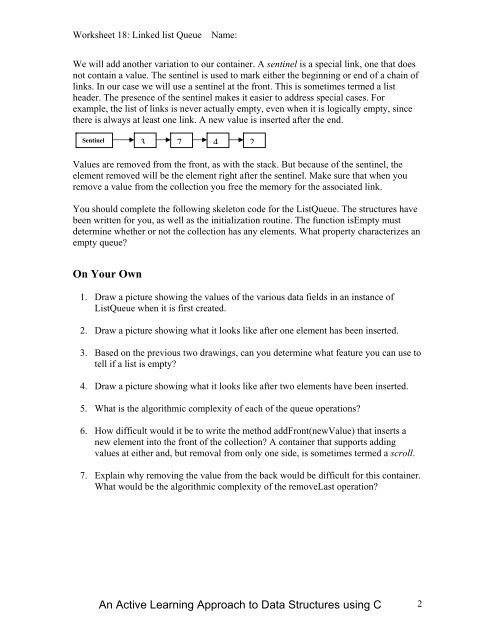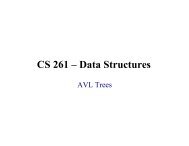Worksheet 18: Linked List Queue, pointer to Tail - Classes
Worksheet 18: Linked List Queue, pointer to Tail - Classes
Worksheet 18: Linked List Queue, pointer to Tail - Classes
Create successful ePaper yourself
Turn your PDF publications into a flip-book with our unique Google optimized e-Paper software.
<strong>Worksheet</strong> <strong>18</strong>: <strong>Linked</strong> list <strong>Queue</strong><br />
Name:<br />
We will add another variation <strong>to</strong> our container. A sentinel is a special link, one that does<br />
not contain a value. The sentinel is used <strong>to</strong> mark either the beginning or end of a chain of<br />
links. In our case we will use a sentinel at the front. This is sometimes termed a list<br />
header. The presence of the sentinel makes it easier <strong>to</strong> address special cases. For<br />
example, the list of links is never actually empty, even when it is logically empty, since<br />
there is always at least one link. A new value is inserted after the end.<br />
Sentinel<br />
3 7 4 2<br />
Values are removed from the front, as with the stack. But because of the sentinel, the<br />
element removed will be the element right after the sentinel. Make sure that when you<br />
remove a value from the collection you free the memory for the associated link.<br />
You should complete the following skele<strong>to</strong>n code for the <strong>List</strong><strong>Queue</strong>. The structures have<br />
been written for you, as well as the initialization routine. The function isEmpty must<br />
determine whether or not the collection has any elements. What property characterizes an<br />
empty queue?<br />
On Your Own<br />
1. Draw a picture showing the values of the various data fields in an instance of<br />
<strong>List</strong><strong>Queue</strong> when it is first created.<br />
2. Draw a picture showing what it looks like after one element has been inserted.<br />
3. Based on the previous two drawings, can you determine what feature you can use <strong>to</strong><br />
tell if a list is empty?<br />
4. Draw a picture showing what it looks like after two elements have been inserted.<br />
5. What is the algorithmic complexity of each of the queue operations?<br />
6. How difficult would it be <strong>to</strong> write the method addFront(newValue) that inserts a<br />
new element in<strong>to</strong> the front of the collection? A container that supports adding<br />
values at either and, but removal from only one side, is sometimes termed a scroll.<br />
7. Explain why removing the value from the back would be difficult for this container.<br />
What would be the algorithmic complexity of the removeLast operation?<br />
An Active Learning Approach <strong>to</strong> Data Structures using C 2

















